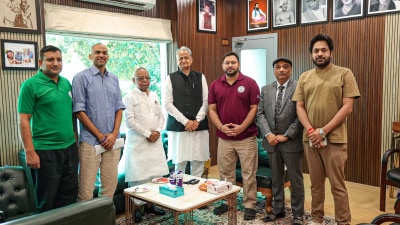The Budget Set
EVERY time the relentless homogenisation of the world grounds my fancies, I take refuge in budget hotels. Not the ideal antidote surely, eac...

EVERY time the relentless homogenisation of the world grounds my fancies, I take refuge in budget hotels. Not the ideal antidote surely, each one is exactly like the other; but it does keep you going. If the place has nothing to look forward to, there’s always the room. Some are memorable in part due to their location, but there are other specimens that deserve objective consideration.
Like this bare basic, hideously tiny room on the uppermost floor of Hotel Green in Gangtok. While I didn’t expect Kanchendzonga herself to wait outside my window every morning, the view from the grimy window that rainy season was decidedly pathetic—the birth of an as yet unpainted concrete structure, with tonnes of discarded building stuff that greeted one’s eyes as they fell.
|
CHEAP DRILLS
|
|||||
|
Things to keep in mind while travelling tight |
|||||
Daytime in Gangtok was fine, I used to be out all day, but they served melancholia in the evenings at Hotel Green. The electricity was forever playing truant (the owner blamed nearly everything on the Indian government) and even when present, didn’t do much good.
A lone 40 watt lamp, which burned with as much fire as a jaded marital bed, produced eerie shadows of a chipped dressing table with a yellowing mirror and a fallen chair.
I tossed and turned under the musty blankets staring at the damp walls or at the door which had some kind of near-transparent glass-like covering at the top. There was a reason behind why I stared at the door—another of the room’s delights. At nights, after people had pushed off to sleep, I would see the hazy outline of a man standing outside the door, as if waiting for a call to get me a midnight snack.
The first time, I didn’t pay too much attention, but a recurrence on the second night spooked me out big time. I whistled loudly and toppled things, but nothing seemed to affect the ‘guy’. In the end, I even went and opened the door a couple of times, but there would be just atmosphere.
My last night was spent sleeplessly staring at the exit and impatiently waiting for dawn. Why didn’t I tell the owner? Oh, he would probably have blamed it on the Indian government.
Then there was this garish dive in Bodhgaya, an amalgamation of Oriental, Indian and alien architecture, its name as forgettable as the hotel itself. I took a deluxe (Rs 400, off-season discount), which, to my six-foot frame, was like a coffin. I could, if I remember correct, touch all four walls with various parts of my body. Not to mention the dusty, late ’80s B&W TV sans remote.
The only thing amusing about the place was its menu which featured such priceless gems as Steak de Bekti Mai Mai and American Burger. The latter was bread fried in used oil along with the mandatory patty, and garnished with, ahem, cherries and sloppy fries.
If hindsight’s vantage point makes it all seem like a great experience, there have been other inns which have delivered even without promising anything. Valley Flower, a tiny, tin-roofed two-storeyed structure in Diskit in the Nubra Valley, was one such.
My 100-bucks-a-day room was a cosy corner, with clean bed linen, and the huge French-type windows opened out to fantastic views of the stark masiffs around Nubra. As pleasing were the views right below my room, which happened to be the hotel’s very own vegetable garden, a riot of fat, green cabbages, blood red tomatoes and faint green pumpkins, all of which constituted the grub for both lunch and dinner for the three days I was there.
The very same feeling of warmth applied to Bihar Tourism’s Gautama at Rajgir, about 20-odd km from the ruins at Nalanda. While not too enticing from the outside, the rooms here, old-world style wooden cot, wooden cupboard and large windows, are unbelievably spacious, especially to a Mumbaiite. There was a rural insouciance in the way cows and goats roamed in the ‘garden’ outside and employees settled in for their evening chat—the Gautama, for the tourist, was ignorant peace in the anarchy of Bihar.
In my weather-beaten book, however, there’s nothing to beat that thatched-roof hut at the Hindu pilgrim town of Gokarna, about three hours from Goa. If the devout drop in to pay obeisance at its many temples, its beaches and coves—with names like Half Moon and Paradise—are littered mostly with blond, frizzy-haired tourists on the lookout for lots of sun and even more trance.
My temporary domicile (at Rs 50 per day) on Om beach was shared with the elderly owner-couple and a couple of their mutts and hens, who kept wandering about through the rickety gate. The menu for the season was hung outside the couples’ only room—toast, eggs, and fish, along with numerous Israeli dishes.
You spent your days in an amphibious manner, alternately soaking yourself in the sea and getting back into the hut’s inviting shade, where you could call out for black tea, food or even beer. I lay down on the mud-baked verandah, if you could call it that, at nights, watching the clear sky and listening to the despondent rhythm of the waves. Sleep came in little spells, but most of the time, you were an insomniac, quite like the sea.





- 01
- 02
- 03
- 04
- 05


























